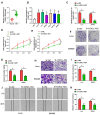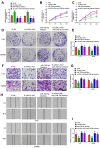Long Non-Coding RNA LOXL1-AS1 Enhances Colorectal Cancer Proliferation, Migration and Invasion Through miR-708-5p/CD44-EGFR Axis
- PMID: 32821123
- PMCID: PMC7423350
- DOI: 10.2147/OTT.S258935
Long Non-Coding RNA LOXL1-AS1 Enhances Colorectal Cancer Proliferation, Migration and Invasion Through miR-708-5p/CD44-EGFR Axis
Abstract
Introduction: Colorectal cancer (CRC), the third most common cancer worldwide, involves a physiological and pathological long non-coding RNA (lncRNA) paradigm shift. It has been reported that the lncRNA LOXL1-AS1 affects tumor development for many kinds of cancers, but its functions and mechanisms in CRC remain unknown.
Methods: Expression levels of LOXL1-AS1 and miR-708-5p within CRC tissues and cell lines were measured using qRT-PCR. The performance of gain-of-function and loss-of-function assays was aimed at examining the effects of LOXL1-AS1 and miR-708-5p; colony formation and cell viability assays were carried out to measure cell multiplication; and Transwell migration and wound-healing assays were carried out for the measurement of cell migration and invasion. Luciferase reporter assay was used to verify the interactions between LOXL1-AS1 and miR-708-5p and between miR-708-5p and the CD44-EGFR signaling pathway. Finally, expression of CD44 and EGFR proteins was measured by Western blot and immunofluorescence assays.
Results: In this study, we reveal that the regulation of lncRNA LOXL1-AS1 occurs within CRC based on the correlation with poor clinical outcomes. LOXL1-AS1 knockdown along with miR-708-5p overpresentation in CRC cell lines inhibited cell multiplication, migration, and invasion. The inhibiting effect of LOXL1-AS1 knockdown on CRC was reversed by upregulating the CD44-EGFR signal pathway. From the perspective of mechanism, LOXL1-AS1 imposes sponging upon miR-708-5p and thereby promotes the CD44-EGFR signal pathway in CRC cells.
Discussion: This study demonstrated that lncRNA LOXL1-AS1 enhances multiplication, migration, invasion, and progression of CRC by sponging miR-708-5p to regulate the CD44-EGFR signal pathway.
Keywords: CD44-EGFR signal pathway; LOXL1-AS1; colorectal cancer; miR-708-5p; migration.
© 2020 Wu et al.
Conflict of interest statement
The authors have no financial interests or conflicts of interest to declare.
Figures






Similar articles
-
Long Non-coding RNA LOXL1-AS1 Facilitates Colorectal Cancer Progression via Regulating miR-1224-5p/miR-761/HK2 Axis.Biochem Genet. 2022 Dec;60(6):2416-2433. doi: 10.1007/s10528-022-10226-3. Epub 2022 Apr 20. Biochem Genet. 2022. PMID: 35441953
-
Potential role of lncRNA LOXL1-AS1 in human cancer development: a narrative review.Transl Cancer Res. 2024 Apr 30;13(4):1997-2011. doi: 10.21037/tcr-23-1450. Epub 2024 Apr 12. Transl Cancer Res. 2024. PMID: 38737681 Free PMC article. Review.
-
LncRNA LOXL1-AS1/miR-let-7a-5p/EGFR-related pathway regulates the doxorubicin resistance of prostate cancer DU-145 cells.IUBMB Life. 2019 Oct;71(10):1537-1551. doi: 10.1002/iub.2075. Epub 2019 Jun 12. IUBMB Life. 2019. PMID: 31188543
-
LncRNA LOXL1-AS1 promotes endometrial cancer progression by sponging miR-28-5p to upregulate RAP1B expression.Biomed Pharmacother. 2020 May;125:109839. doi: 10.1016/j.biopha.2020.109839. Epub 2020 Jan 29. Biomed Pharmacother. 2020. PMID: 32006897
-
Long non-coding RNA LOXL1-AS1: a potential biomarker and therapeutic target in human malignant tumors.Clin Exp Med. 2024 May 2;24(1):93. doi: 10.1007/s10238-024-01355-7. Clin Exp Med. 2024. PMID: 38693424 Free PMC article. Review.
Cited by
-
MiR-211-5p Inhibits the Biological Behaviors of Colorectal Cancer via SPARC-Related Growth Factor Pathways.J Cancer. 2022 Mar 21;13(6):1895-1904. doi: 10.7150/jca.60269. eCollection 2022. J Cancer. 2022. Retraction in: J Cancer. 2022 Apr 26;13(8):2418. doi: 10.7150/jca.73906. PMID: 35399721 Free PMC article. Retracted.
-
MiR-708-5p/Pit-1 axis mediates high phosphate-induced calcification in vascular smooth muscle cells via Wnt8b/β-catenin pathway.Kaohsiung J Med Sci. 2022 Jul;38(7):653-661. doi: 10.1002/kjm2.12542. Epub 2022 Apr 23. Kaohsiung J Med Sci. 2022. PMID: 35460325 Free PMC article.
-
Long Non-coding RNA LOXL1-AS1 Facilitates Colorectal Cancer Progression via Regulating miR-1224-5p/miR-761/HK2 Axis.Biochem Genet. 2022 Dec;60(6):2416-2433. doi: 10.1007/s10528-022-10226-3. Epub 2022 Apr 20. Biochem Genet. 2022. PMID: 35441953
-
Potential role of lncRNA LOXL1-AS1 in human cancer development: a narrative review.Transl Cancer Res. 2024 Apr 30;13(4):1997-2011. doi: 10.21037/tcr-23-1450. Epub 2024 Apr 12. Transl Cancer Res. 2024. PMID: 38737681 Free PMC article. Review.
-
Involvement of long non-coding RNA LOXL1-AS1 in the tumourigenesis and development of malignant tumours: a narrative review.Transl Cancer Res. 2024 Jun 30;13(6):3142-3155. doi: 10.21037/tcr-23-2282. Epub 2024 Jun 5. Transl Cancer Res. 2024. PMID: 38988912 Free PMC article. Review.
References
LinkOut - more resources
Full Text Sources
Research Materials
Miscellaneous

